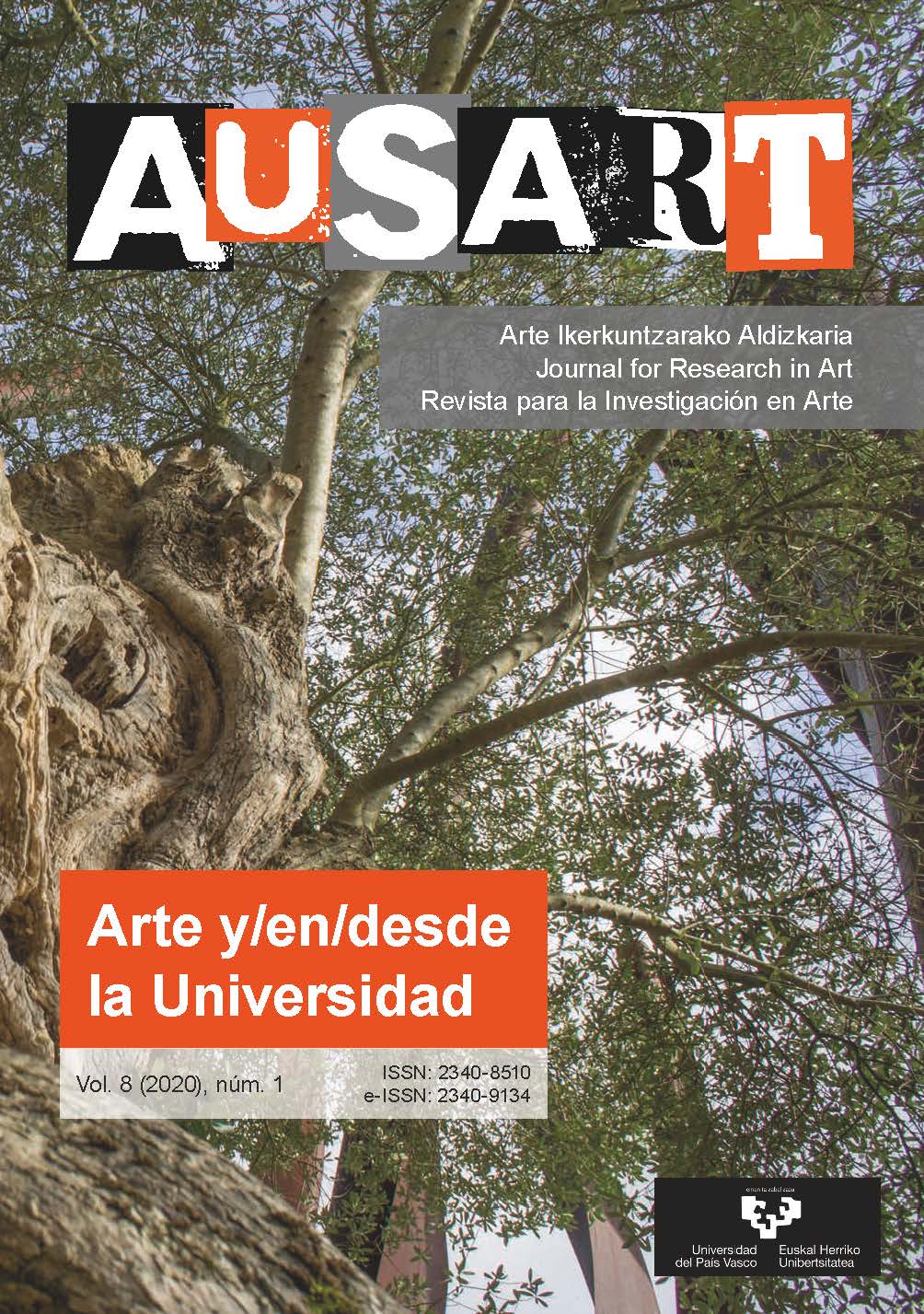A critique of contemporary artificial intelligence art Who is 'Edmond de Belamy'?
##plugins.themes.bootstrap3.article.main##
##plugins.themes.bootstrap3.article.sidebar##
Resumen
'Edmond de Belamy' is a 2018 painting made by french collective Obvious, created using a type of Artificial Intelligence algorithms called Generative Adversarial Networks, which was sold at Christie's auction house in New York for $432,500. This historic event -the so-called auction of the "first artwork made by an AI" raises 3 interesting questions about authorship, originality, and the arts as a space for scientific inquiry. While some think that the current deployment of Machine Learning algorithms and Artificial Intelligence techniques that we are seeing in the art world today may be seen as the ultimate Gesamtkunstwerk`' or total artwork, other points of view express that not only we need this type of cultural artifacts as a critique of industrialized use of Artificial Intelligence, but also a strict criteria has to be delimited in order to review contemporary art made with Machine Learning techniques.
Cómo citar
##plugins.themes.bootstrap3.article.details##
Akten, Memo. 2018. “Machine learning art: An interview with Memo Akten”. Renée Zachariou. Artnome.com, Dec. 16. https://www.artnome.com/news/2018/12/13/machine-learning-art-an-interview-with-memo-akten
Arbiza Goenaga, Mikel. 2018a. “Evolution by design”. MikelArbiza.net (blog), Jul. 31. https://mikelarbiza.net/2018/07/31/evolution-by-design/
Arbiza Goenaga, Mikel. 2018b. “Le Witt’s immortal paintings”. MikelArbiza.net (blog), Jun 18. https://mikelarbiza.net/2018/06/18/le-witts-inmortal-paintings/
Arbiza Goenaga, Mikel. 2018c. “Machine learning art as scientific research”. MikelArbiza.net (blog), Nov. 12. https://mikelarbiza.net/2018/11/12/who-is-edmond-de-bellamy/
Arbiza Goenaga, Mikel. 2018d. “Robotic citizenship is coming!”. MikelArbiza.net (blog), 26 oct. https://mikelarbiza.net/2018/10/26/robotic-citizenship-is-coming/
Arbiza Goenaga, Mikel. 2018e. “The machine will have the idea…”. MikelArbiza.net (blog), Jun 18. https://mikelarbiza.net/2018/06/18/le-witts-inmortal-paintings/
Arbiza Goenaga, Mikel. 2018f. “The true poet is creative”. MikelArbiza.net (blog), Feb. 19. https://mikelarbiza.net/2018/02/19/the-true-poet-is-creative/
Arbiza Goenaga, Mikel. 2018g. “What is blockchain”. MikelArbiza.net (blog), April 4. https://mikelarbiza.net/2018/04/04/what-is-blockchain/
Arbiza Goenaga, Mikel. 2018h. “Who is Edmond de Bellamy?”. MikelArbiza.net (blog), Nov. 12. https://mikelarbiza.net/2018/11/12/who-is-edmond-de-bellamy/
Arbiza Goenaga, Mikel. 2019a. “Artificial Intelligence: a revolution in the art world”. MikelArbiza.net (blog), May 7. https://mikelarbiza.net/2019/05/07/artificial-intelligence-a-revolution-in-the-art-world/
Arbiza Goenaga, Mikel. 2019b. “Computational aesthetics: The beholder needs eyes?”. MikelArbiza.net (blog), May 20.https://mikelarbiza.net/2019/05/20/computational-aesthetics-the-beholder-needs-eyes/
Benjamin, Walter. (1935) 2008. The work of art in the age of mechanical reproduction. Translated by J.A. Underwood. London: Penguin
Bhatia, Richa. 2018. “Neural networks do not work like human brains: Let's debunk the myth”. Analytics India Magazine, Jan.10. https://analyticsindiamag.com/neural-networks-not-work-like-human-brains-lets-debunk-myth/
Bilal, Afaan. 2018. “Artificial neural networks and deep learning”. Becoming Human, Jan. 31. https://becominghuman.ai/artificial-neural-networks-and-deep-learning-a3c9136f2137
Billitz, Nicole. 2014. “Lovelace 2.0 tests creativity”. Versus.com, Nov 24. https://versus.com/en/news/lovelace-2-0-tests-creativity
Boden, Margaret. 2012. “Creativity & AI: Asking the right questions; Interview at Oxford University”. By Adam Ford. Youtube video, 26:52, Jan 16. https://youtu.be/5dEXIOiAsaw
Broeckmann, Andreas. 2016. Machine art in the Twentieth Century. Cambridge MA: MIT
Buckner, Cameron & James Garson. 2019. “Connectionism”. The Stanford Encyclopedia of Philosophy, May 18. https://plato.stanford.edu/archives/fall2019/entries/connectionism/
Çaparlar, Ceyda Özhan & Aslı Dönmez. 2016. “What is scientific research and how can it be done?”. Turkish Journal of Anaesthesiology & Reanimation 44(4): 212-18
Christie's. 2018. “Is artificial intelligence set to become art’s next medium?” Christies.com, Dec. 12 https://www.christies.com/features/A-collaboration-between-two-artists-one-human-one-a-machine-9332-1.aspx
Cohn, Gabe. 2018. “Up for bid, ai art signed ‘algorithm’”. The New York Times, Oct. 22. https://www.nytimes.com/2018/10/22/arts/design/christies-art-artificial-intelligence-obvious.html?ref=oembed
Danto, Arthur C. 1998. “The end of art: A philosophical defensa”. History and Theory 37(4): 127-43
Elgammal, Ahmed, Bingchen Liu, Mohamed Elhoseiny& Marian Mazzone. 2017. “CAN: Creative Adversarial Networks, generating ‘art’ by learning about styles and deviating from style norms”. ArXiv.org, Jun. 21. https://arxiv.org/abs/1706.07068
Elgammal, Ahmed. 2017. “Generating ‘art’ by Learning about styles and deviating from style norms”. Medium.com, Jun. 26. https://medium.com/@ahmed_elgammal/generating-art-by-learning-about-styles-and-deviating-from-style-norms-8037a13ae027
Elgammal, Ahmed. 2018. “Meet AICAN, a machine that operates as an autonomous artista”. The Conversation, Oct. 17. https://theconversation.com/meet-aican-a-machine-that-operates-as-an-autonomous-artist-104381
Gayford, Martin. 2016. “Robot art raises questions about human creativity”. MIT Technology Review, Feb. 15. https://www.technologyreview.com/2016/02/15/162067/robot-art-raises-questions-about-human-creativity/
Giles, Martin. 2018. “The GANfather: The man who’s given machines the gift of imagination”. MIT Technology Review, Feb. 21. https://www.technologyreview.com/2018/02/21/145289/the-ganfather-the-man-whos-given-machines-the-gift-of-imagination/
Goodfellow, Ian J. et al. 2014. “Generative adversarial networks”. ArXiv.org, Jun. 10. https://arxiv.org/abs/1406.2661
Hui, Jonathan. 2018. “GAN: What is generative adversarial networks GAN?”. Medium.com, Jun. 19. https://medium.com/@jonathan_hui/gan-whats-generative-adversarial-networks-and-its-application-f39ed278ef09
Invaluable. 2019. “How artificial intelligence is changing the face of art”. Invaluable.com, Jan. 29. https://www.invaluable.com/blog/ai-art/
Jordan, Ken. 1998. “Defining multimedia”. IEEE Multimedia 5: 8-15
Knight, Will. 2017. “5 Big predictions for artificial intelligence in 2017”. MIT Technology Review, Jan 4. https://www.technologyreview.com/2017/01/04/154761/5-big-predictions-for-artificial-intelligence-in-2017/
Kogan, Gene. 2018. “The neural aesthetic @ ITP-NYU: Lecture 11, Autonomous artificial artists”. Youtube video, 2:43:06, Dec. 4. https://www.youtube.com/watch?v=Dqudnjj5wSo
Krome, Sven. 2018. “Decentralized Autonomous Art: Art in the blockchain foreshadows our future”. Here 360, Aug. 28. https://360.here.com/decentralized-autonomous-art-art-in-the-blockchain-foreshadows-our-future
Lazic, Sanja. 2017. “Is authorship in art a victim of appropriation?”. Widewalls Modern & Contemporary Art Resource, July 24. https://www.widewalls.ch/authorship-in-art/
Locke, Nancy. 2015. “How photography evolved from science to art”. The Conversation, Mar. 11. https://theconversation.com/how-photography-evolved-from-science-to-art-37146
López de Mántaras Badía, Ramón. 2016. "Artificial Intelligence and the arts: Toward computational creativity”. In The next step: Exponential life, Jay David Bolter et al.; publishing coordination, Nuria Martínez Deaño; translation, Wade Matthews. Madrid: BBVA
Monoskop. 2020. “Neural aesthetics: A resource on recent work between art/design and artificial neural networks in machine learning”. Monoskop.org, May.14. https://monoskop.org/Neural_aesthetics
Morris, Andrea. 2018. “We need to talk about sentient robots”. Forbes.com, Mar. 13. https://www.forbes.com/sites/andreamorris/2018/03/13/we-need-to-talk-about-sentient-robots/#2ccae0681b2c
New Atlas. 2015. “Creative AI: The robots that would be painters”. Newatlas.com, Feb. 16. https://newatlas.com/creative-ai-algorithmic-art-painting-fool-aaron/36106/
Offert, Fabian. 2019. “The past, present, and future of AI art”. Skynet Today, June 3. https://www.skynettoday.com/editorials/ai-art-history
Packer, Randall. 2013. “The real history of multimedia”. Inside/Out, Sep. 23. https://www.moma.org/explore/inside_out/2013/09/23/the-real-history-of-multimedia/
Pearson, Jordan. 2014. “Forget Turing, the Lovelace test has a better shot at spotting AI”. Vice.com, Jul. 8. https://www.vice.com/en_us/article/pgaany/forget-turing-the-lovelace-test-has-a-better-shot-at-spotting-ai
Reichardt, Jasia. 1987. “Machines and art”. Leonardo 20(4): 367-72
Smith, Glenn W. & Frederic Fol Leymarie. 2017. “The machine as artist: An introduction”. Arts 6(2), 5. https://doi.org/10.3390/arts6020005
Sukis, Jennifer. 2018. “The relationship between art and AI”. Medium.com, May 16. https://medium.com/design-ibm/the-role-of-art-in-ai-31033ad7c54e
Vicent, James. 2018. “How three french students used borrowed code to put the first ai portrait in Christie’s”. Theverge.com, Oct. 23. https://www.theverge.com/2018/10/23/18013190/ai-art-portrait-auction-christies-belamy-obvious-robbie-barrat-gans

Esta obra está bajo una licencia internacional Creative Commons Atribución-CompartirIgual 4.0.

Atribución-CompartirIgual 4.0 Internacional (CC BY-SA 4.0)
Usted es libre de:
- Compartir — copiar y redistribuir el material en cualquier medio o formato
- Adaptar — remezclar, transformar y construir a partir del material para cualquier propósito, incluso comercialmente.

